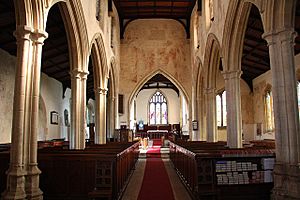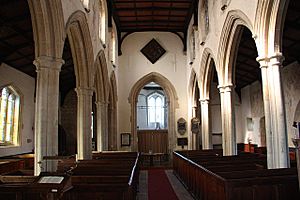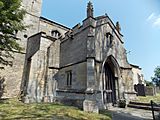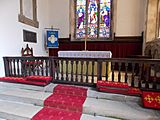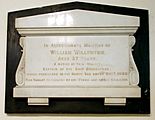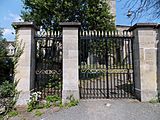St John the Evangelist's Church, Corby Glen facts for kids
Quick facts for kids St John the Evangelist Church, Corby Glen |
|
|---|---|
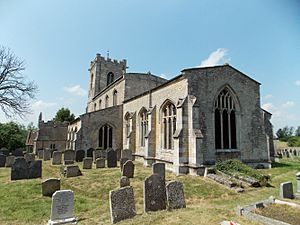
Church of St John the Evangelist from the south-east
|
|
| 52°48′48″N 0°30′57″W / 52.8132°N 0.515708°W | |
| Country | |
| Denomination | Church of England |
| Website | https://corbyglen.church |
| History | |
| Founded | 12th century |
| Dedication | John the Evangelist |
| Architecture | |
| Heritage designation | Grade I |
| Designated | 1968 |
| Architectural type | Norman, Perpendicular, Decorated |
| Specifications | |
| Materials | limestone, rubble |
| Administration | |
| Parish | Corby Glen |
| Benefice | Corby Glen Group of Parishes |
| Deanery | Deanery of Beltisloe |
| Diocese | Diocese of Lincoln |
| Province | Canterbury |
The Church of St John the Evangelist is a historic Church of England church in Corby Glen, Lincolnshire, England. It is dedicated to John the Evangelist. This church is about 9 miles (14.5 km) south-east of Grantham. It is famous for its amazing medieval wall paintings from the 14th and 15th centuries.
St John's is part of the Corby Glen Group of Parishes. This group also includes other churches like St Andrew's at Irnham and St Nicholas' at Swayfield.
Contents
A Look Back in Time: Church History
When the Domesday Book was written in 1086, there was no church or priest mentioned in Corby Glen.
Building the Church
The church building we see today started in the 12th century. Over time, it grew bigger and changed.
- 14th Century: Side aisles were added. A special chapel called the Lady Chapel was built in the north aisle before 1319. A porch and a short tower were also built, and the main part of the church (the chancel) was made larger. Some of the oldest wall paintings in the north aisle are from this time.
- 15th Century: The church had a huge makeover. The roof of the main area (the nave) was raised, and a row of windows called a clerestory was added to let in more light. The chancel was extended, and two new windows were put in. Another chapel was created. The tower was made taller, and the old porch was replaced with a new one that had a room for the priest above it. More wall paintings were added during this period.
Later Changes and Discoveries
In 1860, the church was repaired, and new pews (church benches) were put in. The tower was fixed up in 1928.
In 1939, a churchwarden (a person who helps manage the church) made an exciting discovery. They found medieval wall paintings hidden under old, flaking whitewash.
Because of its history and beauty, St John's Church was given a special "Grade I listed" status by English Heritage in 1968. This means it's a very important historic building.
Church Design and Features
St John's Church is built from limestone and rubble stone. It has a nave (main seating area), a chancel (area around the altar), north and south aisles (side sections), a square tower, a south porch, and a chapel. The church shows different building styles, including Norman, Perpendicular, and Decorated.
Outside the Church
The bell tower has three levels and a battlement (a wall with gaps for defense) at the top. The highest part, the belfry, has openings for the bells and gargoyles that help drain water. At the bottom of the tower, there's a carving that names the builder, Thomas de Somersby.
The north aisle has a doorway and three windows. The south aisle also has windows from the 15th century. The south porch, built in the 14th century, has two floors. The upper floor used to be a room for the priest. Inside the porch, there are stone benches.
Near the church entrance, there are old wrought iron gates and stone pillars from the early 1800s. These are also listed as historic.
Inside the Church
The church can seat 206 people. The roof of the nave has decorative stone supports called corbels, which are shaped like funny or scary faces. The main arches inside the church are supported by large columns.
Above the main arch leading to the chancel, you can still see where the old roof used to be. There's also a small doorway that once led to a loft above the rood screen (a screen that used to separate the nave from the chancel).
The communion rail around the altar in the chancel was put in during the 17th century. It was meant to stop dogs from entering the sanctuary (the holy area around the altar). Near the south door, there's a strong iron-bound chest from the 15th century.
Some of the stained glass windows are memorials to people. You can find old pieces of medieval stained glass in some windows. The church font (where baptisms happen) is from the 13th century. It's octagonal (eight-sided) and sits on a marble base added in 1893.
Amazing Wall Paintings
The medieval wall paintings at St John's are the most special part of the church. They date from the 14th and 15th centuries.
- One painting shows a "gigantic St Christopher," who was nearly 11 feet (3.3 meters) tall!
- In the clerestory (the upper windows), there are scenes from the Nativity (the birth of Jesus), including the Virgin Mary, the Child Jesus, and the Three Wise Men.
- In the north aisle, you can see St Anne teaching the Virgin Mary.
- Another painting shows the Seven Deadly Sins and a "Warning to Swearers." In the middle of this painting is a Pietà (Mary holding the body of Jesus), surrounded by "devils and elegantly dressed youths."
- A very rare painting in the UK shows Saint Michael weighing a soul. The Virgin Mary is shown helping the soul by using her rosary.
- On the south aisle wall, there's a "Tree of Jesse" design.
Church Bells
The church has six bells that are used for change ringing (a special way of ringing bells in a pattern). Four of these bells were made for the church between 1580 and 1628. Two more bells, made in 1935, were added in 2013.
In 1975, the old wooden frame for the bells was replaced with a strong steel one. At that time, a bell from the old grammar school was hung to be a separate Sanctus bell, rung during church services. This bell was made in 1691.
Church Organ
St John's has a small organ with five stops (which control the sound). It was probably made by Taylor of Leicester. The church got this organ in 1949 from Stamford School to replace an older one. The Taylor organ was repaired in 1997.
Gallery



